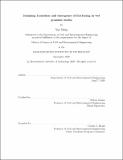Jamming transition and emergence of fracturing in wet granular media
Author(s)
Meng, Yue(Civil and environmental engineer)Massachusetts Institute of Technology.
Download1227048849-MIT.pdf (1.270Mb)
Other Contributors
Massachusetts Institute of Technology. Department of Civil and Environmental Engineering.
Advisor
Ruben Juanes.
Terms of use
Metadata
Show full item recordAbstract
The interplay between multiphase flow in a granular medium and the displacement of the grain particles generates a wide range of patterns, including fractures, desiccation cracks, and labyrinth structures. There are several controlling parameters behind the morphodynamics that govern the transition between different regimes. A modified capillary number characterizes the crossover from capillary fingering to viscous fingering, and a transition from fingering to fracturing can be achieved either by decreasing frictional resistance. The balance between frictional, viscous, and capillary forces has been studied in experiments and simulations, and has helped understanding the underlying mechanisms for a wide range of phenomena, including fractures in drying colloidal suspensions, and methane migration in lake sediments. In this thesis we study fluid-induced deformation of granular media, and the fundamental role of capillarity and wettability on the emergence of fracture patterns. We develop a hydromechanical computational model, coupling a "moving capacitor" dynamic network model of two-phase flow at the pore scale with a discrete element model of grain mechanics. We simulate the slow injection of a less viscous fluid into a frictional granular pack initially saturated with a more viscous, immiscible fluid. We study the impact of wettability and initial packing density, and find four different regimes of the fluid invasion: cavity expansion and fracturing, frictional fingers, capillary invasion, and capillary compaction. We explain fracture initiation as emerging from a jamming transition, and synthesize the system's behavior in the form of a novel phase diagram of jamming for wet granular media.
Description
Thesis: S.M., Massachusetts Institute of Technology, Department of Civil and Environmental Engineering, September, 2020 Cataloged from student-submitted PDF of thesis. Includes bibliographical references (pages 43-48).
Date issued
2020Department
Massachusetts Institute of Technology. Department of Civil and Environmental EngineeringPublisher
Massachusetts Institute of Technology
Keywords
Civil and Environmental Engineering.